What Shutter Speed Should Be Used If The Lens Is Changed To F/4.0?

Porsche 911 During the Le Mans 24 Hours – 1/xxx second shutter speed
What Is Shutter Speed?
Every photographic camera has a physical shutter, similar a drape, that opens and closes to betrayal the sensor to the calorie-free coming in through your lens when you press the shutter push button. The length of time that this shutter is open is called the shutter speed and too sometimes referred to every bit 'exposure time'. Shutter speed is one of the three sides of our exposure triangle, along with discontinuity and ISO, that let us to control the effulgence of our image. These iii things work together to give us both creative control and as well exposure control for our photos. We can select a fast shutter speed that freezes any activity in a photo, or we tin can select a tedious shutter speed that introduces 'motility blur' to whatsoever moving objects inside our paradigm.
Combining a panning motility of the camera (left to right, or right to left motility) with a slow shutter speed tin exist used to give a sense of speed, as in the car photo that opens this article. It gives a sense of movement to the car, but doesn't mistiness out any of the car's item if you go along the car in the aforementioned spot in the frame as you lot pan. With the running water in the photo beneath, the static camera only blurry water gives the h2o a sense of fluid motion. When yous are taking a photo with your photographic camera in a semi-automatic (Television/AV) or manual exposure way, and then consideration must be given to the required shutter speed for your subject. Most of the time we are looking to freeze our subject with a fast enough shutter speed and capture that one singular moment, merely sometimes the creative effect of a slower speed can also be desirable. What shutter speed is fast enough? Well that volition depend on your subject! Further downwards this article there's a handy reference guide that'll get you lot started with some typical scenarios.
How is shutter speed measured?
A camera's shutter speed is measured as a fraction of a 2d for all speeds that are under a 2d. For example 1/250 means one two hundred and fiftieth of a second, or 1/viii means one eighth of a second. The shutter speeds that are available to choose from might vary depending on the type of camera y'all are using, but typically a DSLR will go from 1/4000 all the way to xxx seconds. Further downward this folio you lot'll find a handy reference chart that shows all of the standard options in between. Some pro level DSLRs will allow even faster speeds than one/8000 and many will have 'BULB' fashion for shooting at longer than 30 seconds. This mode keeps the shutter open for as long as y'all hold down the shutter button.
If yous double your shutter speed then the shutter volition be open for half the corporeality of fourth dimension and so y'all one-half the amount of light that'south reaching the sensor. This is therefore equivalent to a ane-end change in exposure. To maintain the same overall exposure in our image, we must remember the exposure triangle and either double our ISO, or open up our aperture past 1 stop to compensate.
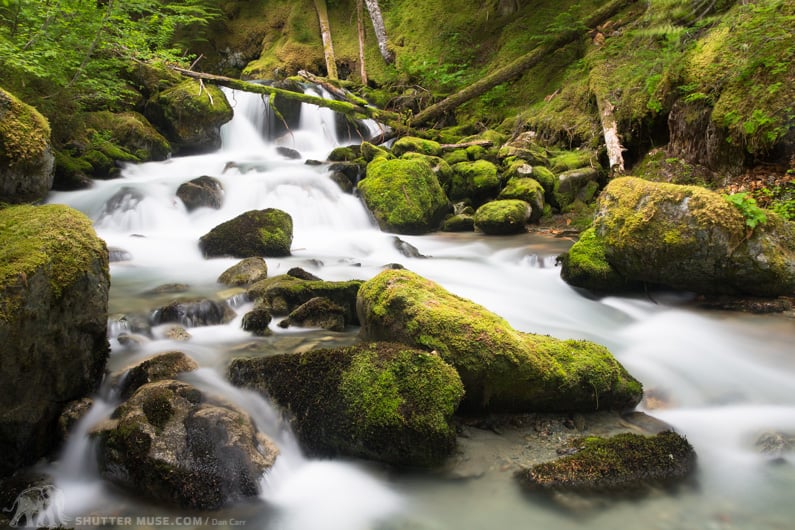
Water running through a creek – xiv second shutter speed
Do yous know what your shutter speed is?
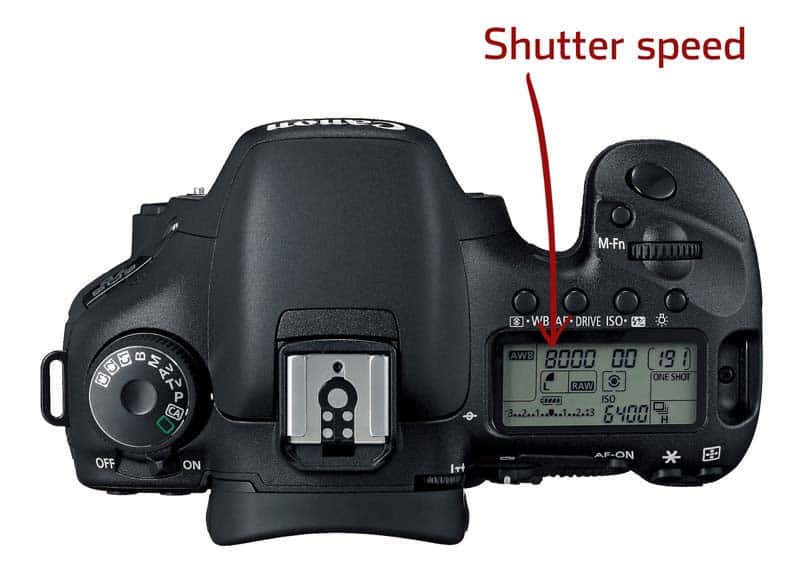
Shutter speed is an of import parameter for your exposure so it'south displayed prominently on all cameras. On a DSLR you lot'll typically discover it in the LCD on the tiptop right-hand side of the camera, as well equally displayed beneath the epitome within the viewfinder. To relieve space in the brandish, cameras do not bear witness the speed as a fraction, and so if yous see '500' in the brandish, this means your shutter speed is actually1/500 2nd. For exposure times of one second or longer, these are typically displayed with a " to denote seconds for example1″,x″ or annihilation up to 30″.
If yous are using a signal and shoot camera, or a DSLR with liveview, then the shutter speed will usually be displayed somewhere around the extremity of the image on your main LCD. If you can't see it, press the 'info' button to cycle though various on-screen displays until you run across all the exposure information.
Controlling your shutter speed
In your camera'southward fully automatic modes, usually designated with a 'P' or an 'A', you won't have straight control over the shutter speed that's chosen for your photo, though you might be able to influence the camera'due south determination by choosing a 'scene'. These are usually simplified situations like 'sports' or 'landscape'. A sports mode will select a faster shutter speed to stop the activeness, whereas a mural mode will choose a slower speed and therefore favour a smaller aperture instead.
My goal for you guys though is to go abroad from using these automated exposure modes and to give you the knowledge to become confident in modes like shutter priority, aperture priority and somewhen fully transmission exposure mode. When learning about shutter speeds, Tv manner (sometimes besides designated past an S) is the all-time to utilize. This mode is chosen shutter priority and it allows us to have direct control over the shutter speed, whilst allowing the camera to select the advisable aperture to get a correctly exposed photograph. When a camera is put into shutter priority, especially DSLRs, it'southward virtually e'er the pocket-size control wheel right next to the shutter button that allows you to conform your shutter speed. Using Tv mode is a vivid style to experiment because you can very chop-chop alter your shutter speed to a variety of settings and see the resulting outcome on your LCD screen.
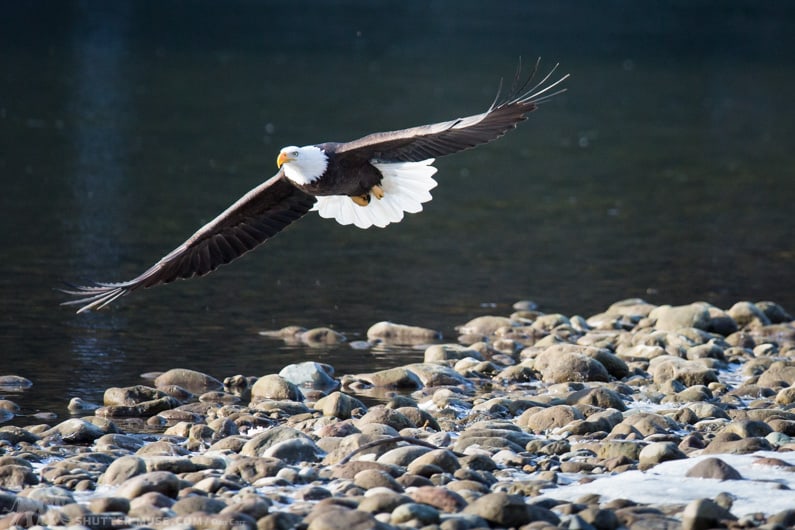
Eagle in flight – 1/2000 second shutter speed
Shutter Speed Chart
Virtually DSLRs give yous the option to choose whether your exposure is adjusted in 1/2 stop, or 1/3 stop increments. The nautical chart below provides you with the common shutter speed options in today'southward digital cameras. What you'll notice if you study information technology closely is that sometimes, the camera'south chosen value is a slight approximation as some fractional speeds would not be applied to use or display on the camera or in the EXIF information of your epitome file.
Remember: Each step forth the full stop scale equates to a doubling (or halving) of the light that reaches your camera's sensor.

Shutter Speed Guidelines
If you're just getting started with your photography and so the following table will requite you lot some general guidelines. It's important to remember though that at that place's very rarely any physical 'rules' in photography as role of the whole process comes down to your own way and creativity. On summit of this, other techniques often come into play and the very top image of the race car is a good example of this. It might exist an activeness shot, merely I used specific technique called 'panning' with a very low shutter speed to requite a sense of how fast the car was going.
Remember: Utilise this table as a starting bespeak, only by no ways is anything set in stone. Don't let it hold back creativity!
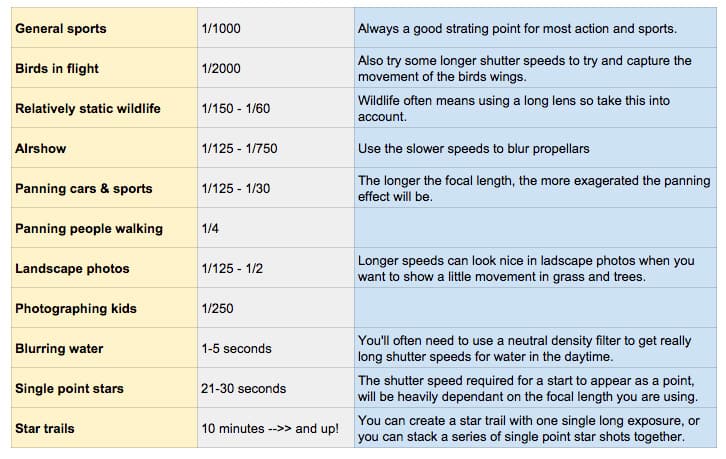
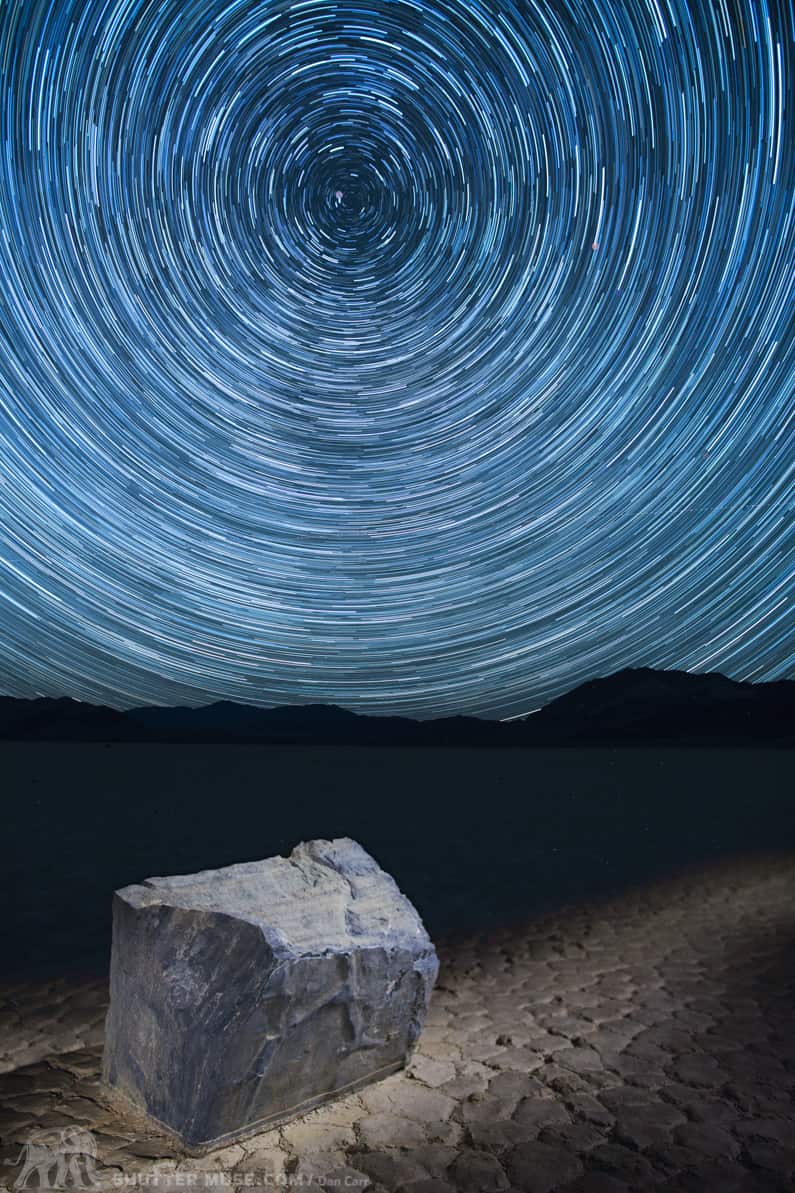
Racetrack Playa star trail
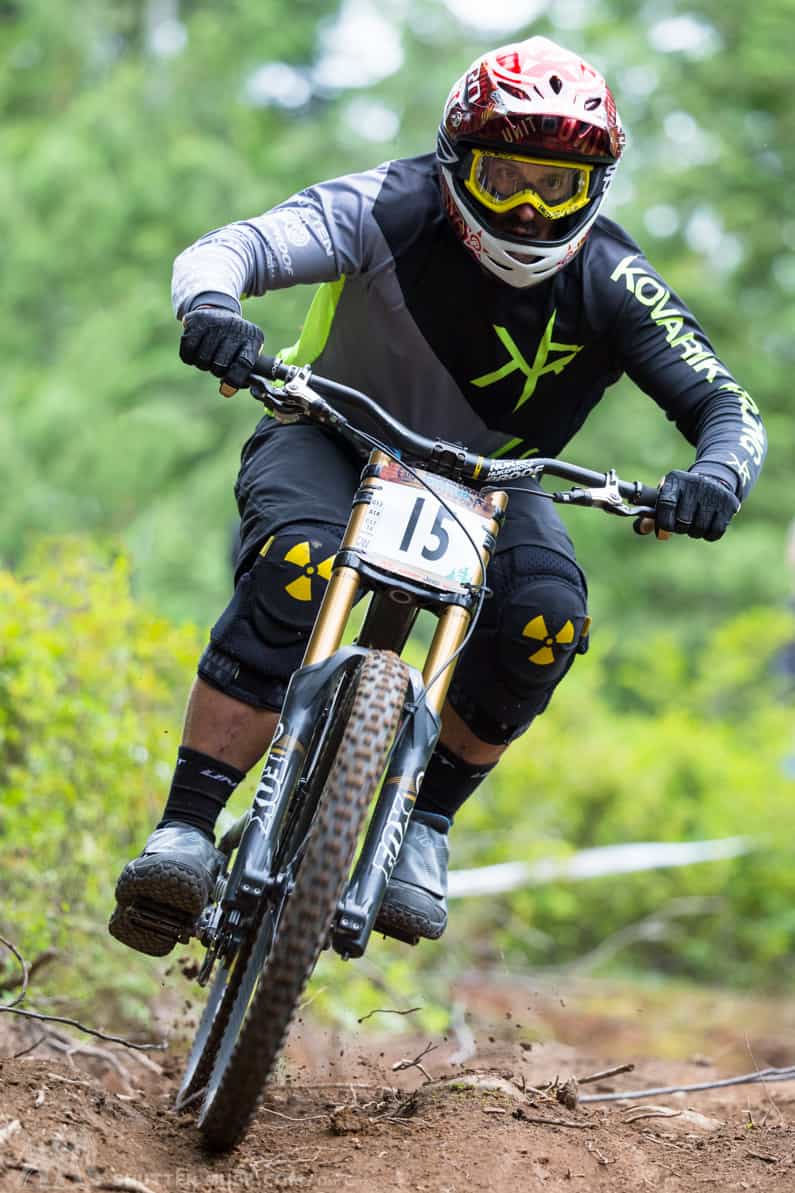
Downhill mount biker – 1/800 2nd shutter speed
Bending and position of lens to subject
An often overlooked part of choosing the correct shutter speed is the position of the lens relative to your subject and this is why the tabular array above should simply be used every bit a guide and non a gospel. It's easier to freeze motion when your subject is coming right towards the photographic camera, than when information technology's crossing perpendicular to your lens. If we take the mount biker in the photo above as our case, you can encounter that he's coming most directly at me and I was able to freeze him perfectly at 1/800 of a 2nd. Had I been standing side-on to the biker as he passed me, 1/800 would not have been nearly plenty to make it look sharp in the terminal image. The relative change of position of the subject is very different during the exposure in those two scenarios. When the bike is coming right at me, every bit in this photo, he's roughly in the same spot in the prototype throughout that 1/800 of a second exposure time. If I was side-on to him though, during that i/800 of a 2d, he would be moving a considerable distance from left to right (or vice-versa). And then when near people expect at freezing action, they tend to think about the speed of the subject first, but in fact neat consideration should be given to the angle at which you intend to shoot them. You lot can even use this to your advantage! Imagine you are trying to shoot this same mountain biker and the calorie-free level is getting low. Switch it up to shoot him from this frontal position and you'll be able to continue shooting for much longer in the low calorie-free than y'all'd be able to if you were shooting him side-on. If your subject is moving diagonally across your frame then you'll need to choose a shutter speed somewhere in the centre of what you'd choice if he was parallel or perpendicular to your lens.
Physical positioning of the lens tin as well have an impact on the required shutter speed. If yous shoot action close-upwardly with a broad-bending lens then your subject field will cross much more of your frame in a given time than they would if you lot used the same lens but stood 10ft further back. This ways that the closer y'all are to your discipline, the faster the shutter speed is needed to freeze motion. On the opposite though, if you are looking for a panning photograph with a blurry groundwork, y'all'll exist able to attain a greater mistiness at a faster shutter if yous place the lens and subject area close together. Always look for ways to apply these things to your reward!
How to get a faster or slower shutter speed
Sometimes you lot'll find that the ambience lighting conditions appear to be belongings you back from choosing the shutter speed that you really want to utilise. This is when we really need to think about that exposure triangle of aperture, shutter speed and ISO. To get the longest exposure time possible in bright daylight, we demand to have the everyman possible ISO and the smallest possible aperture. If that still doesn't become your shutter speed slow enough show the motility you desire in your photo, then you need to expect at using a neutral density filter on your lens. This filter doesn't apply any special effects, it simply darkens the lens and with less low-cal coming in, y'all're able to shoot with a longer shutter speed to get the right overall exposure.
On the other stop of the spectrum, if you are struggling to get a fast enough shutter speed, typically in a low light situation like indoors or after the sun has gone down, so yous'll need to open up your aperture as far equally it will get (move it to the smallest number). If this withal doesn't go your shutter speed up to the necessary setting, then you'll need to increment your ISO. Recollect the exposure triangle and how everything doubles. If you double your ISO, you'll be able to double your shutter speed and notwithstanding maintain the aforementioned overall exposure.
On using tripods
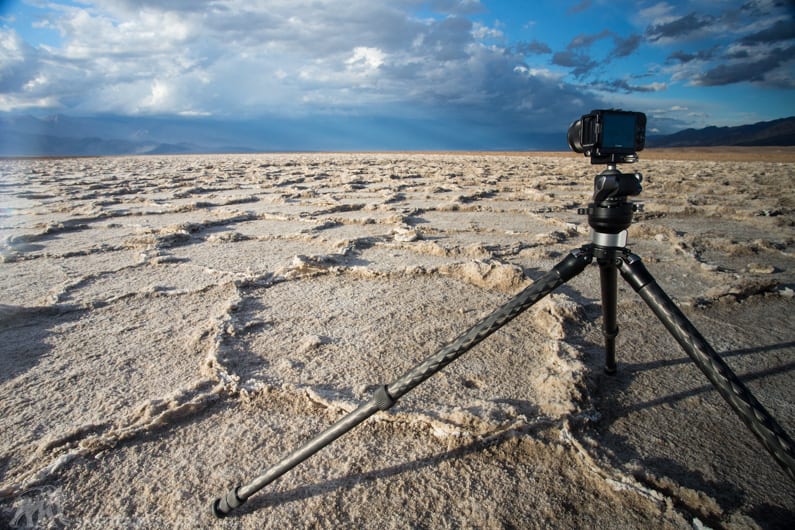
Decease Valley, California
Clearly it's not possible to experiment with some of the speeds we've talked near in this article without a tripod. The speed at which you'll need to apply ane will depend on both the focal length you're shooting at, and as well whether your lens has prototype stabilization or non. Many of today'due south new lenses have a 4-cease paradigm stabilization and this ways that yous tin shoot at much slower shutter speeds than you would be able to without IS. If you lot pick a shutter speed in the table higher up, so scroll down 4 full stops you will exist able to see what a large difference this can make! A general rule of thumb that y'all'll oftentimes hear referred to is that your photographic camera will require some additional support when you shutter speed needs to be less than 1/[Focal Length]. So if you are shooting with a 50mm lens, yous might consider using a tripod if you are experimenting with shutter speeds that are less than 1/50 second. Again, stabilization might come into play, as will your own technique, so this is a mere guideline.
For very long shots like offset trails and photos with running h2o in them, a tripod is going to be a necessity though. I would caution you lot against ownership the cheapest one yous can observe though because in my experience they don't concluding very long and you'll only terminate up buying a new, more than expensive one afterwards on. A practiced tripod should terminal many years though and an first-class tripod could last you lot your entire life (or career). Some excellent brands to cheque out would be:
- Manfrotto
- Induro
- Gitzo
- iii Legged Thing
On using wink to end activeness
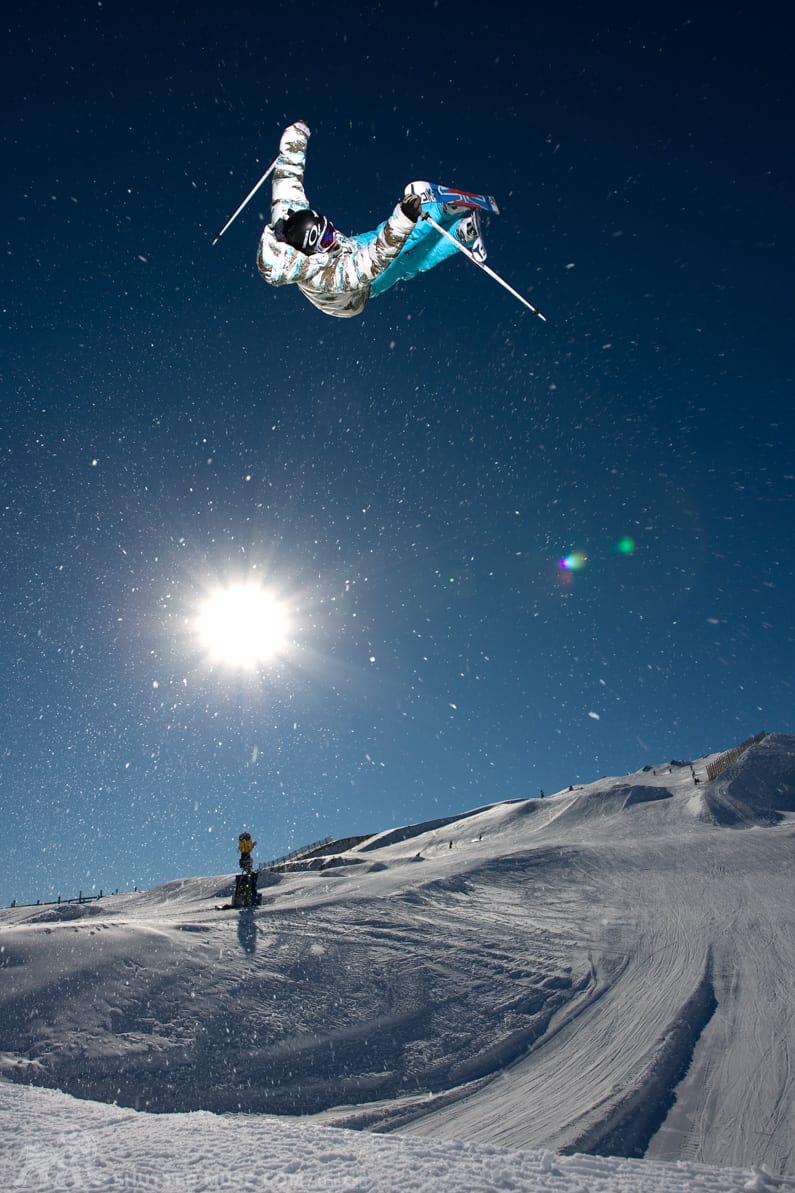
Skier flying loftier in New Zealand – 1/250 shutter speed with flash
I desire to affect this briefly, but an in-depth look at the how and the why of this technique is all-time saved for its ain article. When shooting with a flash, y'all are often limited to the shutter speed that you can utilise. This upper limit of shutter speed is ofttimes referred to as the X-Sync speed or 'cantankerous sync'. Essentially it'due south the fastest speed that you can use before the physical motion of the camera'southward shutter begins to interfere with the burst of calorie-free from the wink. If you could push past this speed (many cameras won't let you), the result would be black bands beyond your image where the bodily shutter is getting in the way of the lite from the wink. Y'all might think this would be extremely limiting when it comes to shooting fast moving objects with flash, but the situation isn't as bad equally it seems. The example image in a higher place was shot with a shutter speed well below what you would normally think you'd need to end action, yet information technology'south tack abrupt! How is this?
The flash burst itself is actually helping u.s.a. cease the action here considering whilst the shutter speed it i/250 2nd, the bosom of light from the flash is simply illuminating the subject for 1/1000 of a second. For ane/250 of a second the photographic camera's shutter is open and ambience lite is slowly painting in the groundwork of the shot, then for simply l/1000 of a second, the flash pops and paints in the skier in the heaven nice and sharp. I'll cover this topic in much more than item subsequently but it'due south good to be enlightened of the nuts so you can proceed an heart out for people using this technique.
Test Your Knowledge! Are Yous Ready For Manual Manner?
If y'all've read the posts well-nigh agreement shutter speed, aperture, ISO and the exposure triangle, you should accept a solid foundation for your photography. Nosotros've designed a quick quiz with 12 questions that will bring everything together and make certain you are ready to move onwards.
You lot might also similar:
- Agreement Aperture
- Agreement ISO
- Understanding The Exposure Triangle
- What Is White Remainder?
What Shutter Speed Should Be Used If The Lens Is Changed To F/4.0?,
Source: https://shuttermuse.com/understanding-shutter-speed/
Posted by: knappspass1986.blogspot.com


0 Response to "What Shutter Speed Should Be Used If The Lens Is Changed To F/4.0?"
Post a Comment